Meeting A Maryland Hero
by Charlie J. Bury, Jr.
Charlie is a retired SFC Maryland Army National Guardsman 29th Division, a
Military Historian, Maryland Military Historical Society, Inc., and a member of the 5th Maryland Vet Corps and 29th Infantry Division Association. All photos are by author.
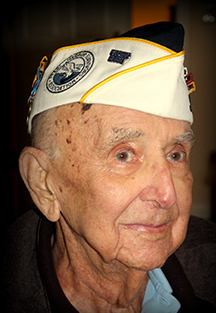 On December 7th, 2012, I posted some photo’s I took at Pearl Harbor during my June 2012 vacation on my Facebook page in remembrance of the Day of Infamy. Upon seeing them, my cousin Margie Stewart made contact with me and said that there was a gentleman named Jean W. Showe who lives at the Sunrise Senior Living apartments in Severna Park, Maryland where she is employed who survived the attack on Pearl Harbor. She then told me that she could arrange a meeting with him, if I would like. I immediately seized the opportunity. On December 7th, 2012, I posted some photo’s I took at Pearl Harbor during my June 2012 vacation on my Facebook page in remembrance of the Day of Infamy. Upon seeing them, my cousin Margie Stewart made contact with me and said that there was a gentleman named Jean W. Showe who lives at the Sunrise Senior Living apartments in Severna Park, Maryland where she is employed who survived the attack on Pearl Harbor. She then told me that she could arrange a meeting with him, if I would like. I immediately seized the opportunity.
I awoke early on Tues, December 18th and got ready for my visit. While driving from my home to Severna Park I thought about what questions I wanted to ask. When I arrived my cousin met me at the front entrance. She then signed me in and escorted me to the veteran’s apartment. She knocked on the door and opened same. As the door opened I saw an elderly gentleman in a wheelchair sitting about 6 inches from a TV.
My cousin said, “Mr. Jean, your visitor is here.” The gentleman reached up, turned off the TV, turned around, faced me and said, “Hello.”
I noticed as soon as I entered his room that this man was very proud of his service. Hanging on the walls were several framed photos of the Light Cruiser USS Raleigh CL-7 and the Destroyer USS DeHaven DD-469. Sitting on a shelf was a photo of a very pretty Navy Nurse, flanked by two USS Raleigh ball caps, and on the wall above was a shadow box of awards and medals.
I introduced myself and sat down, but before I could start asking questions, Mr. Showe said that he was a Pearl Harbor Survivor and started his story.
Mr. Showe said with a smile that in January 1938, he had watched the movie, “Follow the Fleet,” with Fred Astaire and Ginger Rogers. After watching the movie he really liked the Navy uniforms and said to himself, “those guys have a lot of fun; they get the pretty girls, travel around the world and get paid $36.00 dollars a month!” Mr. Showe said that most young men at the time were still struggling with the effects of the great depression and couldn’t find jobs, especially in Hagerstown, Maryland where he lived. Luckily his father was employed with the Western Maryland Railroad. He decided to enlist in the Navy and learn a trade that would get him a good civilian job when his enlistment ended.
After completing his basic training and the Norfolk Navy Yard, he was assigned to the Light Cruiser USS Raleigh (CL-7) He volunteered to be trained as a boiler operator and was given the rate of water tender, 2nd class. Due to Japanese aggression in Manchuria, the USS Raleigh was ordered from San Diego Naval Base to Pearl Harbor on October 5th, 1939. Mr. Showe added that he wasn’t worried at all about Japan. He said, “the Navy was so cocky, who the hell would attack us!” He spent most of 1940 and 41 training, and most of all enjoying the Hawaiian Islands, adding it was indeed paradise.
I asked Mr. Showe where he was during the Japanese attack on Pearl Harbor, 71 yrs ago, December 7th, 1941. He said that he was lying awake in his bunk aboard the USS Raleigh, thinking about going home to see his family. In 28 days he was being discharged from the Navy. Mr. Showe paused a few seconds, looked off into space and then said; “I heard what I thought was a dull explosion,” he again paused, looked at me saying, “I said, ‘What the hell was that?” Suddenly, “General Quarters,” sounded.
Mr. Showe jumped up from his bunk and ran to his battle station near one of the boiler rooms. It was then that he found that the Raleigh had been hit amidship by a Japanese torpedo and that Pearl Harbor was under attack.
The USS Raleigh was moored at berth F-12 on the East side of Ford Island in front of the USS Utah. Mr. Showe said he was attempting to get the steam up in order to operate the bilge pumps, the crew had already made the ship tight by closing all the hatches between compartments. The Raleigh began to list taking on lots of sea water. The boiler had to be shut down in efforts to keep it from being contaminated by salt water.
Soon the ship was listing so badly it appeared that it may capsize. The Captain ordered all hands below decks to come topside. Mr. Showe said he made it to the hatch leading to the main deck and was quickly assigned to run ammo to the anti-aircraft batteries. A Japanese Armor Piercing bomb hit the Raleigh, plunging through three decks and out the hull before exploding at the bottom of the harbor.
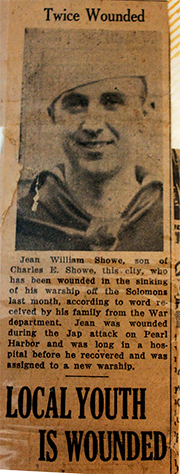 “I saw six, 10, 20 Japanese Planes in the air; our ship was firing everything we had at the Japanese. We were credited with shooting down five planes,” Mr. Showe said. He then reached into a leather bag and pulled out a 4-by-9-inch chunk of greenish metal and handed it to me. It was a fragment of one of the Japanese planes that was downed. Words engraved on the fragment said, part of a Jap plane shot down by USS Raleigh from attack at Pearl Harbor, Dec 7, 1941. “I saw six, 10, 20 Japanese Planes in the air; our ship was firing everything we had at the Japanese. We were credited with shooting down five planes,” Mr. Showe said. He then reached into a leather bag and pulled out a 4-by-9-inch chunk of greenish metal and handed it to me. It was a fragment of one of the Japanese planes that was downed. Words engraved on the fragment said, part of a Jap plane shot down by USS Raleigh from attack at Pearl Harbor, Dec 7, 1941.
Mr. Showe said that he witnessed what was probably as close to hell as anyone could get! He recalled seeing and hearing the USS Arizona explode directly across the 450-acre Ford Island from the Raleigh. The Arizona sunk killing 1,177 sailors many whom still rest with her at the bottom of Pearl Harbor today. The USS Utah berthed at the stern of the Raleigh rolled over after being hit by several torpedoes. Mr. Showe added that his ship (Raleigh) and the Utah were berthed where the US Carriers would normally be. Somehow the men of the USS Raleigh were able to keep their ship afloat and no men were lost.
The night was just as terrifying, said Mr. Showe. The men were exhausted, hungry and afraid. Fires burned out of control, wounded and dead were all over, and there had been reports of a Japanese invasion fleet headed toward Hawaii. “We were scared to death!” Mr. Showe recalls seeing a formation of aircraft flying toward Ford Island; they had all turned on their lights and were clearly visible in the night sky. Every ship that could fired at the formation, shooting several down. Learning later, that the flight was a US squadron returning to Pearl from the USS Enterprise. Several of the pilots were shot down and killed. The Japanese never returned.
The next day the hole in the USS Raleigh was temporary patched and the ship was towed by yard craft and the USS Whitney (AD-4) destroyer tender to the Navy Yard for repairs. On February 21st, 1942 Mr. Showe onboard the USS Raleigh left Pearl Harbor as an escort of a five ship convoy to San Francisco. While in San Francisco, the Raleigh was completely overhauled and assigned to Task Force 15 (TF-15) convoy duty between San Francisco and Hawaii. Mr. Showe was reassigned to the USS DeHaven (DD-469) a brand new Fletcher class destroyer.
Mr. Showe continued to train on the DeHaven, learning everything about the ship’s boiler and propulsion system during sea trials. The USS DeHaven was placed into Convoy Duty November 1942. The first action the ship saw was its last. The destroyer was supporting the battle for Guadalcanal, the first American Offensive operation in the Pacific. The DeHaven escorted Battleships, Supply Ships and helped with smaller operations. “We did a lot of shore bombardment for the Marines,” said Mr. Showe.
On February 1st, 1943, the DeHaven was escorting Six LCT’s (Landing Craft Tank) and a Seaplane Tender attempting to establish a new beachhead at Morovo on Guadalcanal. Nine Japanese planes attacked the DeHaven. Mr. Showe said that during the battle, three enemy planes were shot down. “Three 500 lb bombs hit us. One hit the bridge and killed most of the officers including the ship’s Captain.” He said. “Smoke filled the boiler room, I couldn’t see. I felt something warm running down my leg. I looked, it was blood.” He had been hit by a large piece of shrapnel which he still carries today.
The ship began to go down quickly. Mr. Showe said he tried to find a life jacket from one of the dead sailors lying on the deck, but no one was wearing them. So he decided to jump from the ship. The USS DeHaven sunk two miles East of Savo Island with 167 Killed in Action- 38 wounded including Mr. Showe. He swam to a life raft and was picked up two hours later by another destroyer and put ashore at Guadalcanal.
He was patched up and moved to a medical ward, where he met a marine who had asked him for a smoke. “I don’t have nothing, ”Showe told him. He noticed the Marine had a big rag hanging out of his pocket. “He reached for it and asked if I wanted it.” It was a captured Japanese flag. Mr. Showe then reached into his leather case, pulled out a zip lock plastic bag. Inside the bag was the Japanese flag. He took it with care, unfolded it to show it me.
Mr. Showe also shared a photo album of news articles that his mother had collected. One article described the action in which he was wounded, showing his photo. He also showed me his purple heart.
After Guadalcanal, Mr. Showe recuperated from his wound and was reassigned to another destroyer, this time in the Atlantic Theater. His group escorted supply convoys that were constantly under attack across the Mediterranean. Mr. Showe said, “You were always tense. You hardly ever slept eight hours.” Mr. Showe was put out of action twice by hernias. The second got him shipped from the Atlantic Theater back to Norfolk Naval Base.
Mr. Showe said he finished the war stateside in Bremerton, Washington. While there he met and married his Nurse. They were married 60yrs. Esther Marie (Taddiken) Showe, passed away at age 90. Mr. Showe added with a chuckle, that not many Enlisted men could give an Officer a baby. Mr. Showe learned his trade the hard way but after the war he got the trade job he wanted. He worked 25years at the Naval Research Station near the US Naval Academy. He settled in Pines on the Severn before arriving at the Sunrise Senior Living.
This writer was very blessed to have the opportunity to sit down with a real Maryland Hero. I enjoyed listening to Mr. Showe and I think it was pretty clear he enjoyed having someone listen to him.
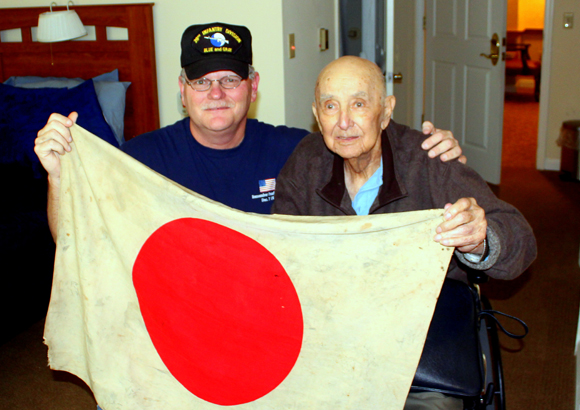 |
The author Charlie Bury Jr. with Mr. Showe in his Japanese flag.
|
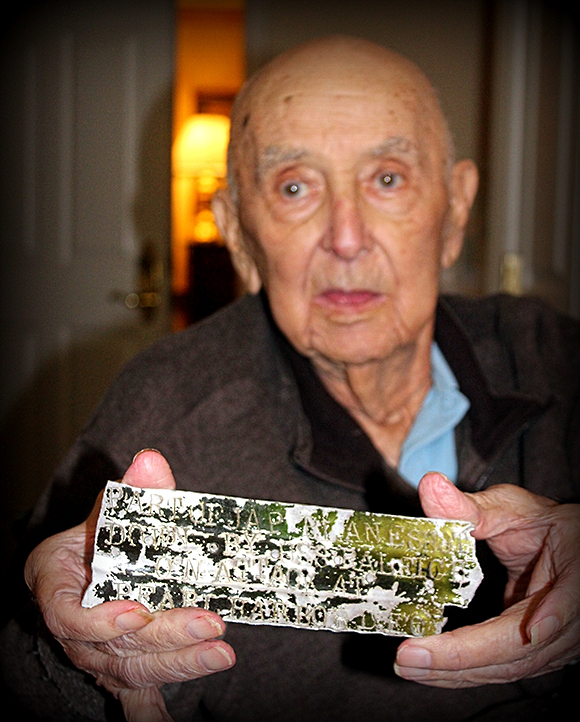 |
Jean Showe shows a fragment from a jap plane shot down by the Raleigh. The plane crashed on Ford island near the ship and he retrieved a piece.
|
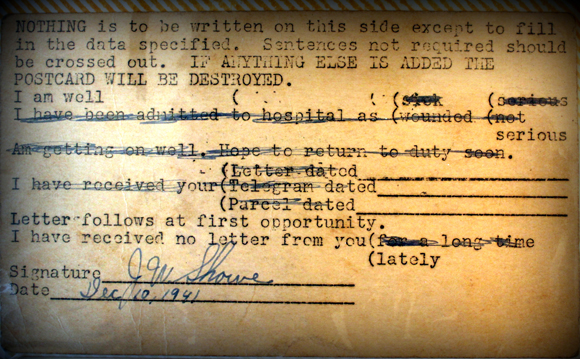 |
| A very rare and unique Pearl Harbor Relic. After the attack many of the survivors wanted to let loved ones know that they were alright. The US Navy didn't want this information getting back to the Japanese so they came up with the Index Card solution. Survivors were allowed to fill out one card and send it home. As you can see they could only fill in few details getting the message back home by simply crossing out what did not relate to them |
|
 On December 7th, 2012, I posted some photo’s I took at Pearl Harbor during my June 2012 vacation on my Facebook page in remembrance of the Day of Infamy. Upon seeing them, my cousin Margie Stewart made contact with me and said that there was a gentleman named Jean W. Showe who lives at the Sunrise Senior Living apartments in Severna Park, Maryland where she is employed who survived the attack on Pearl Harbor. She then told me that she could arrange a meeting with him, if I would like. I immediately seized the opportunity.
On December 7th, 2012, I posted some photo’s I took at Pearl Harbor during my June 2012 vacation on my Facebook page in remembrance of the Day of Infamy. Upon seeing them, my cousin Margie Stewart made contact with me and said that there was a gentleman named Jean W. Showe who lives at the Sunrise Senior Living apartments in Severna Park, Maryland where she is employed who survived the attack on Pearl Harbor. She then told me that she could arrange a meeting with him, if I would like. I immediately seized the opportunity. “I saw six, 10, 20 Japanese Planes in the air; our ship was firing everything we had at the Japanese. We were credited with shooting down five planes,” Mr. Showe said. He then reached into a leather bag and pulled out a 4-by-9-inch chunk of greenish metal and handed it to me. It was a fragment of one of the Japanese planes that was downed. Words engraved on the fragment said, part of a Jap plane shot down by USS Raleigh from attack at Pearl Harbor, Dec 7, 1941.
“I saw six, 10, 20 Japanese Planes in the air; our ship was firing everything we had at the Japanese. We were credited with shooting down five planes,” Mr. Showe said. He then reached into a leather bag and pulled out a 4-by-9-inch chunk of greenish metal and handed it to me. It was a fragment of one of the Japanese planes that was downed. Words engraved on the fragment said, part of a Jap plane shot down by USS Raleigh from attack at Pearl Harbor, Dec 7, 1941.

